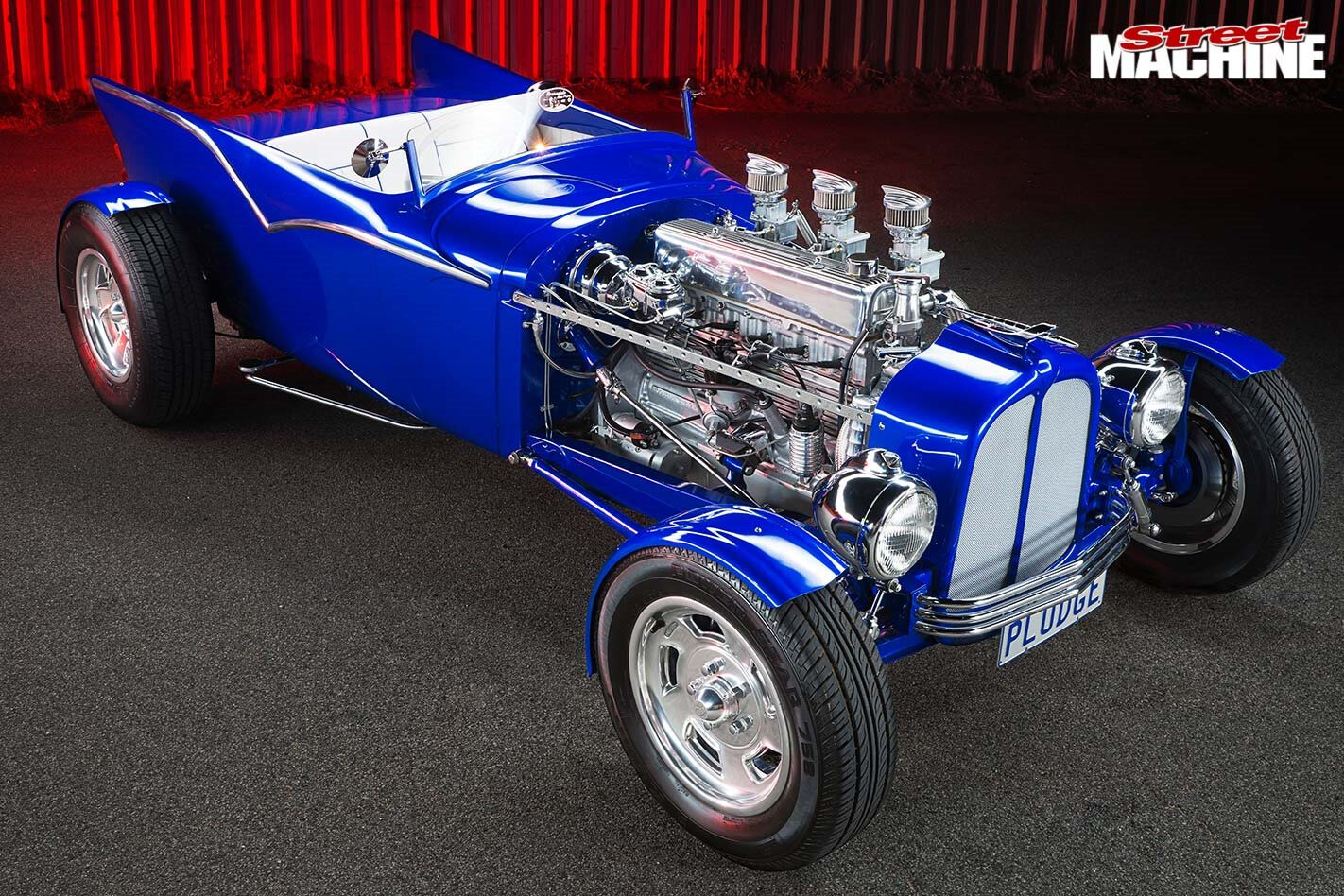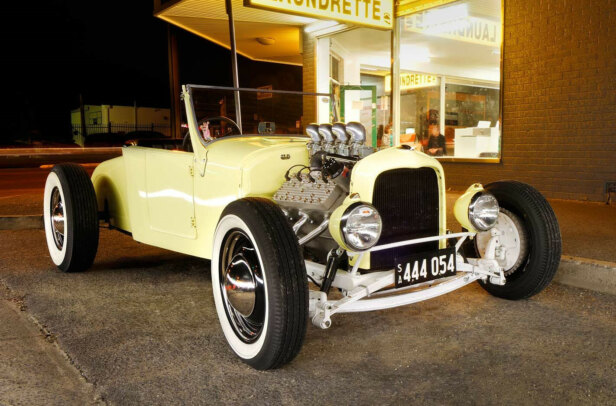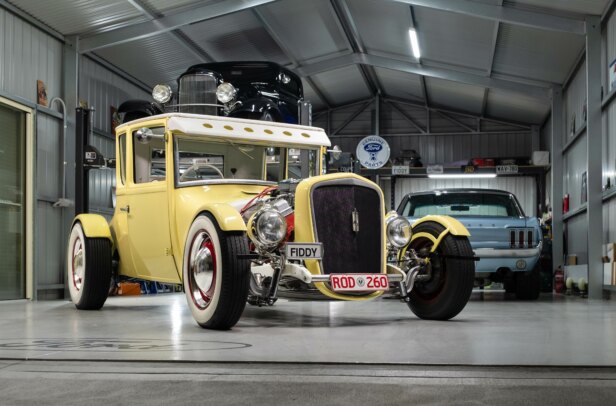INSPIRATION. Everyone that builds a modified car has found it somewhere. Whether it was in the pages of a magazine or from older siblings or mates that had hot cars, at some point there was an ignition source, a spark that set you on the path to build your dream machine.
This article was first published in the September 2014 issue of Street Machine
Alan ‘Plodge’ Smart found his in the pages of old hot rod magazines, Ed Roth’s crazy show rods of the 60s and in more recent times, the wild custom rods of US builder, Aaron ‘Plowboy’ Grote. Aaron has done three to date – Spacetruck, Lunar Lander and Atomic Punk – and they all have the signature feature of much-later-model rear sheet metal.
Alan had known of Aaron’s work for a while, and one day while tripping over stuff in the workshop he noticed he had a few bits that together might form the basis of a Grote/Roth-influenced custom rod – with enough imagination, the vision was clear as day. The end result, a splendid rod Alan has dubbed Voodoo Blue, shows what can be achieved with a few spare parts, some ingenuity and plenty of creativity.
“We already had the cowl and the chassis; the front end and the motor were there; I even had the wheels,” Alan said. “The motor and the wheels came off a ’58 Chev ute I used to have.
“We started off with a ’27 Dodge chassis, but by the time we mocked it all up and figured out what we were going to do, there was only about a metre and a half of it left, so we figured we’d be better off just building it out of 100x50mm RHS tube.
“The fins are off an AP3 Chrysler Royal that had been gas-axed off a car.”
Not surprisingly, they weren’t exactly a bolt-on fit. “We tidied up the cuts then fabricated the panel between the two fins at the back and the top, neatened them up at the front and then worked out where to join them onto the cowl. We cut off the bottom section and had to fabricate all of that. Basically, the bottom six inches of the car from the cowl back is fabricated, and we then made a boot lid to suit what was there.”
Figuring out where everything would go was a case of trial and error and eyeball engineering. “At one stage we had it mocked up longer, but it didn’t quite look right,” Alan said. “We had the fins further back but it looked a bit funny with more of the fin hanging behind the wheel.”
The car was first set up with a 100-inch wheelbase – the same as a Model T – but a couple of inches were added so that the front axle could be pushed forward and allow the fitment of a larger radiator.
With that big long Chev Blue Flame six in it, Alan reckoned there would even be room for a V8 with a front-mounted blower, but this car was always destined to run a six – partly to be different, but mostly because it’s what they had lying around.
The rest of the drivetrain is GM too, with a Turbo 350 swapping the gears while a diff out of a one-tonner gets the back wheels turning.
Paint and trim were the biggest investments, and Alan had plans to go with a pretty wild metal-flake paint job, but decided a straight metallic blue had enough pop and suited the car perfectly. “I really have to say a huge thank you to Glenn Baker for the killer paint job. If you saw what he had to fix!”
The white tuck-and-roll job was handled by First Class Trimming, who didn’t have much area to cover, but had to make sure the seats were thin and practical due to the tight confines of the cabin.
It looked cosy in there, and it was time to see whether I could fold all six-and-a-bit feet of myself into it – time for a road test!
It’s a safe bet ergonomics wasn’t high on the list when this car was put together. I had a few issues, like bumping the shifter out of gear with my left knee and not being able to swing the steering wheel all the way around because my hand would get jammed between it and the side section. But it didn’t take long for me to get used to these minor idiosyncrasies.
The first thing I noticed was how far ahead of you the front wheels appear; the car’s not that long, but as you sit just in front of the rear wheels, the front wheels seem a lot further away than usual. This leads to a very different experience when you’re taking corners – you follow the car around the turn, not the other way around.
But it turned in nicely, changed direction quickly and had hardly any body-roll when cornering. With the engine set way back behind the front axle, there’s next to no weight over the front tyres, which no doubt helps greatly in the cornering stakes.
The brakes were also excellent, which isn’t too surprising considering they’re hauling up about half the weight they would normally have to.
In the go department, Alan thankfully reined in the mighty power of the Blue Flame six by only connecting one of the three single-barrel Strommies, so while it’s no neck-snapper, it still gets along pretty well thanks to its light weight, covering the sprint to 60mph (96km/h) in just under 12 seconds.
Craig Clements, who helped greatly in the build of Voodoo Blue and who has probably driven it more than anyone, offered this summation of what it feels like after an extended ride: “After you’ve got out of the car, it feels like a couple of chicks have spent an hour bashing you over the head with pillows.” Uh, yep.
ALAN SMART
1927 DODGE ROADSTER
Paint: Metallic blue
DONK
Type: Chevrolet 235ci Blue Flame
Inlet: Offenhauser
Carbs: Triple Strombergs
Radiator: Aussie Desert Cooler
Exhaust: Custom headers into 2in single system
SHIFT
Box: Turbo 350
Converter: 2000 stall
Diff: Holden one-tonner
BENEATH
Front end: Stock ’32 Ford axle
Shocks: So-Cal Speedshop tube (f), So-Cal coil-overs (r)
Steering: Chevy Vega
Brakes: XF Falcon discs (f), Holden drums (r)
ROLLING STOCK
Rims: Halibrand Swirl; 15×6 (f), 15×7 (r)
Rubber: 195/60/15 (f), 235/70/15 (r)
THANKS
Craig Clements for inspiring and helping me with a lot of the build, for bouncing crazy ideas off and for being as weird as me; Glenn Baker for the killer paint job; First Class Motor Trimming; Vinci Chrome; Phil Pavicich for helping with the nerf bars; Ben Forster for welding classes; Cranksters Hot Rod Club; the staff at Armadale Auto Parts; my wife, for not complaining when I worked back three or four hours a night; Ed Roth and Aaron ‘Plowboy’ Grote for the ideas and influences




Comments